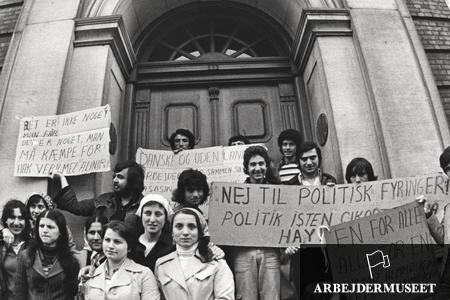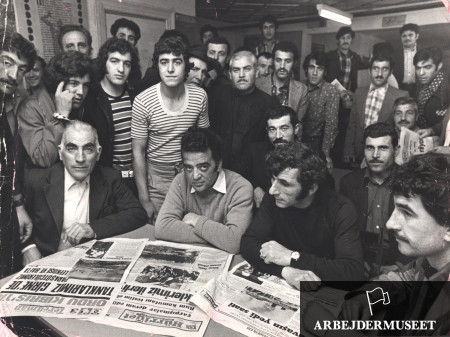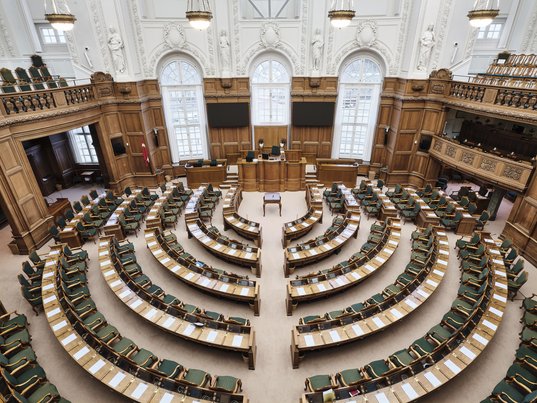Danish immigration policy, 1970-1992
In 1973, the Social Democrat government introduced an immediate stop to labour immigration because of growing unemployment. Immigration was, however, not a particularly problematic subject in the political and public debate in the 1970s. From the beginning of the 1980s, more refugees came to Denmark, particularly from the Middle East and the Global South, where many countries were ravaged by crises, war and civil conflict. In 1983, the Danish Parliament passed a new Aliens Act that was known as Europe’s most liberal. The large numbers of immigrants that subsequently came to Denmark, together with integration problems, led to parliament passing a number of limitations to the Act in 1980s. At the end of the 1980s, immigration became more important in the political and public debate due to, amongst other things, the Progress Party (Fremskridtspartiet) strongly highlighting the issue.

1967-1970: Guest workers come to Denmark
In the 1960s, Denmark was characterised by economic growth and prosperity. This led to an even greater demand for labour within the industrial sector, and it could not be filled by improvements in production technology or the increase of women in the workforce. Employers were therefore permitted to invite guest workers (often also called ‘foreign workers’ (fremmedarbejdere)) to the country. In 1967 the first workers came from countries such as Turkey, Pakistan and Yugoslavia. Most of the new guest workers were men and the expectation was that they would only live and work in Denmark for a few years after which they would return to their homeland.
In 1970, there were approximately 20,000 non-Danish workers in Denmark.
1973: Denmark introduces an immediate stop to labour immigration
In 1970, the Danish Social Democrat government introduced an immediate cessation on labour immigration, but it was quickly relaxed. This was firstly because of Denmark’s EEC-membership which, from January 1973, meant that free movement of workers was guaranteed within the European community of which Denmark was now a part. Secondly, the economic boom meant that the need for labour continued, so the government relaxed the rules for immigration from other EEC countries.
At the end of 1973, the first oil crisis hit Denmark which led to unemployment for the first time in more than a decade. The Social Democrat Minister for Work, Erling Dinesen (1910-1986), chose therefore, on 29th November 1973, to enforce an immediate stop on labour immigration from countries outside the EEC – a decision that the trade union movement was extremely happy with. Longer stays were only possible if you had obtained refugee status or had been granted the right to family reunification with a Danish citizen or a foreigner living in Denmark who had a work permit. There was broad political consensus over Dinesen’s decision.
Overall, however, debate concerning refugees and immigrants was not high on the political agenda in the 1970s. The Social Democrat government and the labour movement had, on the whole, a rather sceptical and cautious approach to the subject. They feared that immigration would lead to wages being reduced and that there would be a relatively high need for social assistance amongst immigrants.
At the end of the decade, numerous mayors of the larger towns and cities, and particularly those from the municipalities in the western part of Copenhagen (vestegn), had begun to articulate concerns about problems with integration and the tendency towards the development of a ‘parallel society’. A small number of cases regarding the expulsion of foreign criminals was also a matter of public concern. Two of the most significant concerned a female narcotics courier from the Philippines, and a Mexican man who was suspected of espionage. The cases mobilised politicians, the media and opinion makers, which put enormous pressure on successive Social Democrat governments with respect to establishing clear guidelines for deciding residence, work and expulsion cases throughout 1970s.

PICTURE: Visit to a club for Turkish guest workers in Copenhagen, in the wake of the Turkish invasion of Cyprus, 1974. Photo: Per Daugaard, Arbejdermuseets Arkiv (The Workers Museum's Archive).
1977: Committee on immigration law established
In 1977, the Social Democrat government established a cross-party committee with the aim of forming an overview of how immigration, one of the most unregulated areas, could be better managed. The intention was, on the one hand, to create more legal certainty for non-Danes and, on the other, ensure that the authorities could exercise authority over those residing in Denmark.
The committee, which was ultimately not unanimous, issued a report in 1982. The majority suggested that, firstly, a clarification of the rules on residence permits and expulsion should be undertaken, including the humanitarian considerations that could be involved in both cases. Secondly, all expulsions should in future be conducted by the courts instead of the previous practice of the border police (fremmedpolitiet) making decisions in a purely administration process. Thirdly, a refugee appeal court should be set up which would be similar to a court where potential complaints could be dealt with. The minority of the committee had a much more lenient attitude towards the granting of refugee status and family reunification, which should, in their view, be safeguarded through existing legal processes.
January 1983: Draft of the new Aliens Act
On 20th January 1983 the Minister of Justice of the new centre-right government, Erik Ninn-Hansen (1922-2014), put forward a bill for a new Aliens Act. The bill was based on the recommendations made by the majority of the 1977 committee on immigration law, and the Minister did not expect that it would give rise to more than routine adjustments. There remained broad political consensus regarding the cessation of labour immigration, and the beginning of the 1980s was a time when refugees and immigrants were still not high on the political agenda.
Nevertheless, there appeared to be an alternative view amongst political parties that were not part of the government, which supported the recommendations put forward by the minority of the committee on immigration law. The Social-Liberal Party (Det Radikale Venstre), the Socialist People’s Party (Socialistisk Folkeparti (SF)) and the Left-Wing Socialists (Venstresocialisterne (VS)) were clearly for this alternative recommendation and managed to get the Social Democrats onboard. Ninn-Hansen’s bill was therefore sent back to the committee where the minority agreed with this approach. This led to the introduction of a range of fundamental changes. The Chairman for the Danish Refugee Council, law professor Hans Gammeltoft-Hansen, acted as an informal consultant in this process and, regarding certain parts of the law, even as a ghostwriter.
In an attempt to win the agenda back, Erik Ninn-Hansen heavily criticised the new bill openly. In a big interview in the newspaper Jyllands-Posten on 10th April 1983, he warned that family reunification would undermine the benefits resulting from the cessation of labour immigration which had been in place since 1973 and which remained still in force. He referred to both the 300,000 unemployed in Denmark and to the fact that the social welfare system would attract many foreigners. At the same time, he insinuated that there was a danger of the legislation being misused by people who had no legal right to be in the country and who likewise had no right to access social services. Additionally, he warned that frustration over the “large flood” of people coming to Denmark and subsequent misuse of the legislation could lead to clashes between different groups of the population. He explicitly used the potential racial tensions. The minister recommended that caution should be exercised if the country was to be preserved as a nation-state in the longer term. The interview received much attention, particularly because in the 1980s it was unusual that the large parties highlighted this particular issue.

PICTURE: The debating chamber in the Danish parliament. Photo: Folketinget, Christoffer Regil.
3 June 1983: Europe’s most liberal act for non-citizens
On 3rd June 1983, the Danish Parliament passed the new Aliens Act as a result of the unusual majority existing between the parties that were not in government (an ‘alternative majority’), and it came to be known as the most liberal in Europe. The right to asylum was granted as long as a person’s case on asylum or family reunification with a refugee or asylum seeker was being processed. Additionally, what had previously been two different categories of refugee were given equal legal status, namely, refugees under the United Nations Convention on Refugees, and de facto refugees, who did not fulfill the UN Convention, but whose circumstances were of such a nature that substantial reasons suggested they should not be sent back to their countries of origin. Furthermore, it was set down in law that foreign citizens with a permanent residence permit or refugee status in Denmark had the right to obtain family reunification, and this did not only apply to children and spouses, but also to parents over the age of 60 as well as more distant relatives in certain cases. In this way, the Danish law went further than the demands of the UN Convention.
1983-1987: Restrictions to the Aliens Act
In 1984 – a year after the new Aliens Act successfully passed through parliament – a significant increase in the number of asylum seekers could be observed. In 1983, there had been a good 3,000 applicants in total, and in 1984, 4,300 applied. The number of asylum seekers continued to increase and in 1985, there were 8,700 applicants and 9,000 in 1986. The vast majority were given residence permits. The majority came from Iraq and Iran who were at war with one another. Other groups were Palestinians, Lebanese and Tamils who had fled from civil war and uprisings.
In light of the increase in numbers, the Minister of Justice Erik Ninn-Hansen wanted to revise the Aliens Act. In October 1984, he argued in Parliament that the influx had happened because asylum seekers knew about the liberal Danish law and therefore chose precisely Denmark to come to. The parties who were not part of the government held a majority on the issue (the Social Democratic Party (Socialdemokratiet), the Social-Liberal Party (Det Radikale Venstre), the Socialist People’s Party (Socialistisk Folkeparti (SF)) og the Left-Wing Socialists (Venstresocialisterne (VS)). They rejected the minister’s arguments as well as the need for any restrictions. They thought instead that one should as a matter of principle help people in need. The politicians’ opinions with respect to foreigners and refugees became gradually more polarised throughout the first half of 1985 and the same applied to the population’s. In Denmark, there were groups of people who collected clothes and other necessities for the refugees, but there were also cases of disturbances and vandalism against refugee housing.
In autumn 1985 the Social Democratic Party’s view began, however, to move closer to the centre-right government’s. This was because, firstly, the number of refugees arriving continued to increase and, secondly, Social Democrat mayors had expressed concern over problems with integration, especially in areas of social housing in the municipalities surrounding Copenhagen. Integration was unsystematic and hesitant, and most refugees were housed in municipalities which already had social problems. In December 1985, the four parties of the government, together with the Social Democratic Party and the Progress Party, agreed that further restrictions to the lenient provisions in the Aliens Act were necessary. This led to provisions which allowed asylum seekers whose claims were deemed “apparently groundless” being rejected at the Danish border. Although the Social-Liberal Party, SF og VS voted against, the majority held by the political parties which had originally carried the liberal Aliens Act had collapsed.
In 1986, Erik Ninn-Hansen initiated other revisions of the law which held three further, fundamental restrictions:
- the legal requirement for asylum to be given to de facto refugees (those who did not fulfill the criteria under the UN convention on refugees) had to be removed.
- asylum seekers should be sent back to the country they came from, if those countries had signed the UN convention on refugees.
- responsibility for their removal should be placed on the transport companies rather than the state, that is, airlines or railway companies must return an asylum seeker to the last secure country, if s/he did not fulfill the conditions required to apply for asylum.
The revisions were supported by the government, the Social Democratic Party and the Progress Party, while the Social-Liberal Party, SF and the VS voted against.
1988-1990: The Progress Party’s revolt against Danish immigration policy
On 1st January 1988 the national police commissioner gave his yearly report which set out that the number of foreigners in Denmark was 14% higher than in 1986, which meant that there were 82,530 foreigners living in Denmark in total (out of a population of just over 5.1 million). While many of this number were from other western countries, national attention was mainly directed towards other 'udlændinge' (foreigners), with non-western backgrounds and who, by their appearance, culture and behaviour, were more visible.
Amongst the Danish population, there was a growing interest in the subject, and the strongly anti-immigration Progress Party was able to gain 7 mandates at the general election in May 1988, bringing their total up to 16 (out of 179). In the course of the following period of government, the Progress Party called for local referenda to allow each municipality to take a view on whether they would receive refugees or not. They also wanted municipal institutions to stop paying special attention to Muslim eating habits. The Progress Party’s political chairman, Pia Kjærsgaard (b.1947) called the party's policy "a justified revolt" against "the foolish refugee policy that the Left and the Conservatives stand for".
The Liberal Party and the Conservative People’s Party were, through the entire election campaign, conscious of the fact that it was a tricky question – over and above the Progress Party’s sustained and effective instrumentalisation of it. This was partly because the Social-Liberal party were part of the government at that time and a liberal immigration policy was crucial to them. It was also because the parties themselves were internally split over the issue, particularly the Liberal Party. The largest opposition party, the Social Democrats, largely failed to discuss the matter of immigration due to similar internal disagreement, and also because they wanted to placate the Social-Liberal Party with a view to future collaboration.
The anxiety surrounding the subject was clearly reflected in the legislation of the time as no major changes were adopted in the area during the period 1988-90.
1991-1992: The Palestinian Cases
In the summer of 1991, over 300 Palestinians from Lebanon had their asylum applications rejected, and the reason given was that the conditions in Lebanon were becoming more peaceful and that there were therefore no grounds for asylum. The asylum seekers were to be sent home. In September, nearly 100 of the rejected asylum seekers occupied Enghave Church in Copenhagen and later Blågårds Church, also in the capital. The priest and a united congregation gave the Palestinians ‘church asylum’, that is, protection under the sanctity of the church, a principle that has existed since Roman times. This type of protection does not have legal status in Danish law, but the authorities were in any event very reluctant to violate it.
The occupation of the church created a lot of attention around the case and led to a people’s movement that demanded that the Palestinians should get permanent residency on humanitarian grounds. The Conservative Minister of Justice Hans Engell (b.1948) rejected all appeals indicating that the cases had been treated according to the rules, and that the legal provisions allowing residency for humanitarian reasons were intended only for individuals and not for groups consisting of hundreds of people.
In January 1992, a Member of Parliament for the Social-Liberal party, Elisabeth Arnold (b. 1941), addressed parliament on the issue. She put forward a bill that would give the group of Palestinians permanent residency for humanitarian reasons given that they had already been in the country for more than a year. Arnold soon got support from SF and the Social Democratic Party. On 27th February 1992, the bill passed into law with a majority carried by parties that were not in fact in government allowing the 321 Palestinians from Lebanon to obtain permanent residence permits.
‘The Palestinians' law’ has subsequently been heavily criticised for breaking with the usual legislative practice and the rule of law because it was about specific people and did not apply to others. The law was equally important due its undermining of the asylum system. At the time, the law further polarised the debate on immigration; an opinion poll showed that less than 20% of the population supported it.
Thanks go to danmarkshistorien.dk for allowing us to translate this article. Read this article in Danish on danmarkshistorien.dk.
Further reading:
- Heidi Vad & Klaus Petersen, ‘Denmark: A national Welfare State Meets the World’, in Grete Brochmann and Anni- ken Hagelund, Immigration Policy and the Scandinavian Welfare State 1945-2010 (Basingstoke: Palgrave Macmillan, 2019) pp. 97-148.
- Helen Wray ‘Regulating Spousal Migration in Denmark’ Journal of Immigration Asylum and Nationality Law (2013) 27,2 pp. 139-161.
- Poul Villaume, Udlændingelov i Gyldendals og Politikens Danmarkshistorie [Immigration law in Gyldendal's and Politiken's Danish History], (2002-2005).
- Thorsten Borring Olesen og Niels Wium Olesen, De danske ministerier 1972-1993 [The Danish Ministries 1972-1993], 5, part 1 (2017), and part 2 (2018).